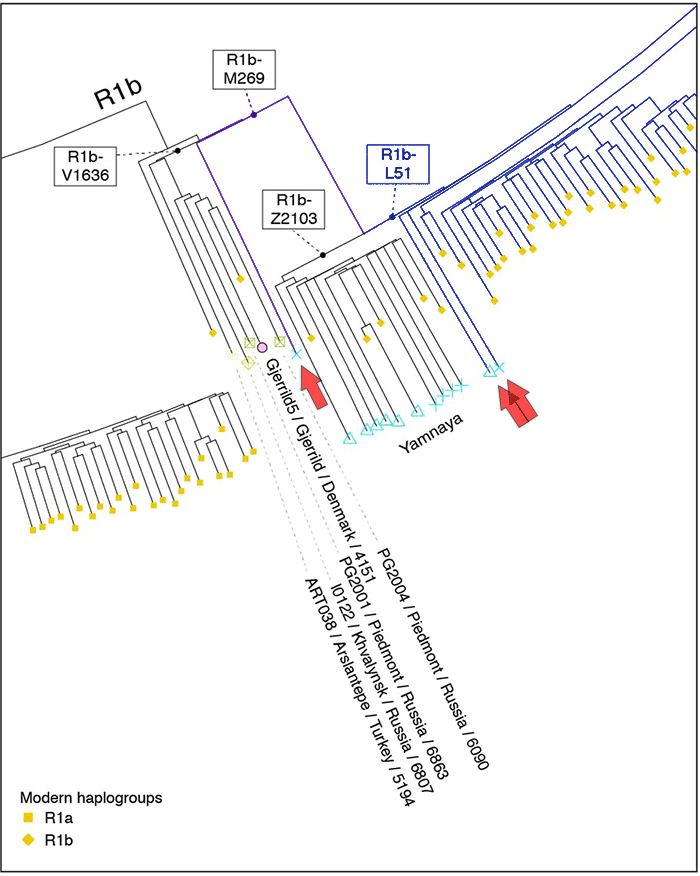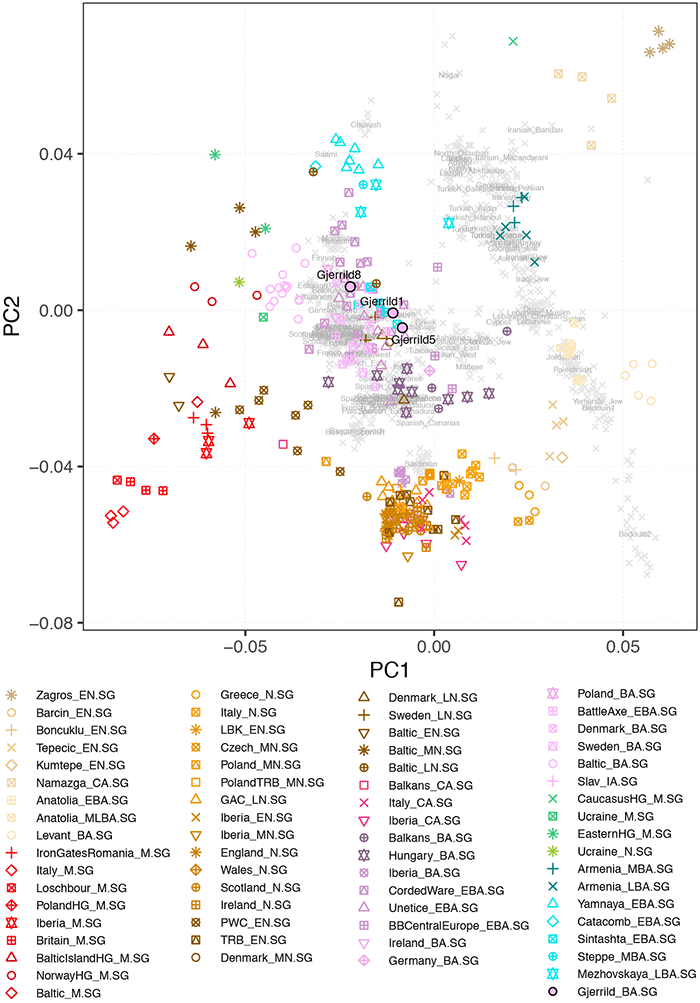The BAM files from Egfjord et al. (2021) are out, and Y-SNPs of two-year-old Nordic MN_LN/LN migrant Gjerrild 5 (ca. 2284-2035 calBC) were accurately reported, which means that the sample will need to be labelled R1b>L754>L389>(pre-?)V1636, since one derived read Y125110+ (A->G) in this and one ancestral in a Progress2 sample, PG2001, cannot be used to infer anything certain.
NOTE. It has one derived read (A->T) for FT3897 at the R1b>L754>L389>V1636>Y83069 level, but the other 8 SNPs ancestral, which is not really helpful to define a potential pre-Y83069 branch, given the doubts above. A possible relative could be the Srubnaya sample I0233 from Novosel’ki, of dubious hg. V1636>Y83069>BY56339. Gjerrild 5 is now part of the Ancient DNA Dataset, and appears also in the Web Map of ancient Y-DNA and mtDNA.

5-to-6-year-old migrant child Gjerrild 8 (2575-2345 BC), the earliest MN sample from the investigated stone cist – corresponding to the Ground and Upper Grave period of the Single Grave culture – shows a standard Central European Corded Ware-like ancestry. Despite its poor coverage, which does not allow for reliable Y-SNP calls, he was probably of hg. P(xR1a). Its genetic profile is in line with all other currently sampled CWC groups from Poland, Germany, and the Czech Republic, where an increasing bottleneck under rare patrilineages – such as basal R1a-M198* and R1a-M417* (including R1a-CTS4385) – is clearly seen in an east-to-west cline.
NOTE. Gjerrild 8 is derived for P>M45 (1 read) and P>P226 (1 read), ancestral for R1a (F3466, 1 read A->C) and R1a>M459>M198 (M810, 1 read T->G). See my comments below.
This contrasts with Gjerrild 5, who shows more EEF-related admixture, which could be due to increased mixture with locals (as earlier female Gjerrild 1 might suggest) or to incoming Bell Beakers. Based on the data we already have of later samples from the Low Countries (and its likely offshoots from the British Isles), Nordic LN, and Northern European BA, all these Central European CWC and “Single Grave” groups (whatever that term actually means for each research group) got massively replaced in terms of patrilineages with the arrival of R1b-L51-rich Bell Beakers from the south, at the same time as their Steppe ancestry occasionally increased in some regions, clearly due to female exogamy with other Steppe-rich populations.
NOTE. A point of likely contention in the future is the position of the so-called “East Danish Single Grave culture” population, which – supporting Iversen (2016) – seems rather part of the Swedish R1a-Y2395-dominated Battle Axe groups, as proven by RISE61, a Middle Neolithic individual from Kyndeløse, of subclade R1a-Z284, also interred in a megalithic burial and showing an ancestry similar to Gjerrild 5.

The rarity of V1636 beyond South-East Europe could point to it as part of Bell Beaker vanguard settlers in Central Europe, similar to other rare Z2103 and L151* lineages among them, or to a connection with the rare R1a-M417(xZ646) lineages among early Corded Ware groups that migrated west.
It could thus be the first sample to offer either a definitive, direct connection in terms of patrilineages of Indo-Anatolian-speaking Khvalynsk and Core-Indo-European-speaking Yamnaya with the Nordic Late Neolithic, the Bell Beaker-derived maritime dominion spreading Pre-Proto-Germanic (cf. Prescott 2018); or alternatively an ancestral link with the Steppe-related ancestry of the Pre-Corded Ware population from the forest-steppes.
We could already infer well before these samples that the once surely widespread R1a-M417(xZ645)-rich Corded Ware patrilines were almost fully replaced by Bell Beakers and succeeding BA groups because of the merely testimonial presence of modern descendants in Northern Europe and Scandinavia. Their late TMRCA (ca. 2600 BC for R1a-CTS4385), incompatible with the expected common ancestor dating to the pre-Corded Ware period, is nevertheless coincident with the bottlenecked survival and spread of many other Neolithic lineages after the Bell Beaker period.
In fact, the current absence of R1a-CTS4385 subclades in the ancient DNA record among sampled Germanic tribes, and its presence among few Early Vikings, suggest that most if not all surviving (known) R1a(xZ645) lines from Europe were probably associated during the Bronze Age exclusively with Scandinavia, most likely initially with Jutland, since the Battle Axe-related R1a-Y2395 lineages must have become integrated into the maritime Nordic LN society either in East Denmark or farther to the North and East.
NOTE. As for the origin of I1-rich Nordic LN groups, as I said in the previous post, we are again in uncharted waters as far as ancient DNA goes.
The fact that Bell Beakers replaced in a mater of centuries a population that had itself quickly replaced earlier Neolithic groups reveals another radical qualitative change in terms of societal structure. Most likely, the adaptation of the Yamnaya to a sedentary way of life in the Carpathian Basin, as well as the adoption of the increasingly popular Proto-Beaker package along the Danube River settlements, are at the core of that overwhelming success that helped them sweep over (almost) all of Late Neolithic Europe, triggering the start of the European Early Bronze Age.

Concerning proto-languages, the short-lived Single Grave community (ca. 1st to 3rd quarter of the 3rd millennium BC) adopted regional material cultures as it got disconnected from the eastern Corded Ware core region, likely admixing gradually with locals over time, which – coupled with the absolute lack of any indisputable trace of their language – leaves this question open, although I doubt that anything other than an extinct Proto-Uralic branch can fit. The presence of non-Indo-European substrate languages behind Insular Celtic and (more dubiously) in the Nordwestblock, as well as the heavily Neolithic-influenced features incorporated into the North-West Indo-European dialects expanding north – like those proper of the language of the geminates – are all good candidates for further research.
Gjerrild settlers were thus possibly part of one of the latest regional SGC groups to survive until they were culturally (and in great part also genetically) replaced by Bell Beakers and their descendants. Their interaction with incomers was nothing compared with the complex, long-lasting integration of Battle Axe-derived peoples of Northern and Eastern Fennoscandia, who became the native West Uralic substrate that influenced some of the changes from Pre- to Proto-Germanic, as it has recently become more evident.
For those visitors of my age or older, you could possibly regard this social clash between groups that were culturally so different – and the quick demise of Single Grave clans – in a romanticized way, with the occasional collaboration between frontier groups.
Related
- Recent Yamnaya-related intrusion in a Denmark Late Neolithic burial
- Predictions about the genetic change from Single Grave to the Late Neolithic in Denmark
- Proto-Indo-European kinship system and patrilineality
- The complexities of 3rd millennium Steppe-related migrations
- Yamnaya ancestry: mapping the Proto-Indo-European expansions
- European hydrotoponymy (III): from Old European to Palaeo-Germanic and the Nordwestblock
- Pre-Germanic and Pre-Balto-Finnic shared vocabulary from Pitted Ware seal hunters
- European hydrotoponymy (I): Old European substrate and its relative chronology
- European hydrotoponymy (II): Basques, Iberians, and Etruscans after Old Europeans
- Pre-Germanic and Pre-Balto-Finnic shared vocabulary from Pitted Ware seal hunters
- Bell Beaker/early Late Neolithic (NOT Corded Ware/Battle Axe) identified as forming the Pre-Germanic community in Scandinavia
- Minimal Corded Ware culture impact in Scandinavia – Bell Beakers the unifying maritime elite
- Pre-Germanic born out of a Proto-Finnic substrate in Scandinavia
- Kortlandt: West Indo-Europeans along the Danube, Germanic and Balto-Slavic share a Corded Ware substrate
- Reproductive success among ancient Icelanders stratified by ancestry
- Genomic analysis of Germanic tribes from Bavaria show North-Central European ancestry
- Germanic tribes during the Barbarian migrations show mainly R1b, also I lineages
- On Proto-Finnic language guesstimates, and its western homeland